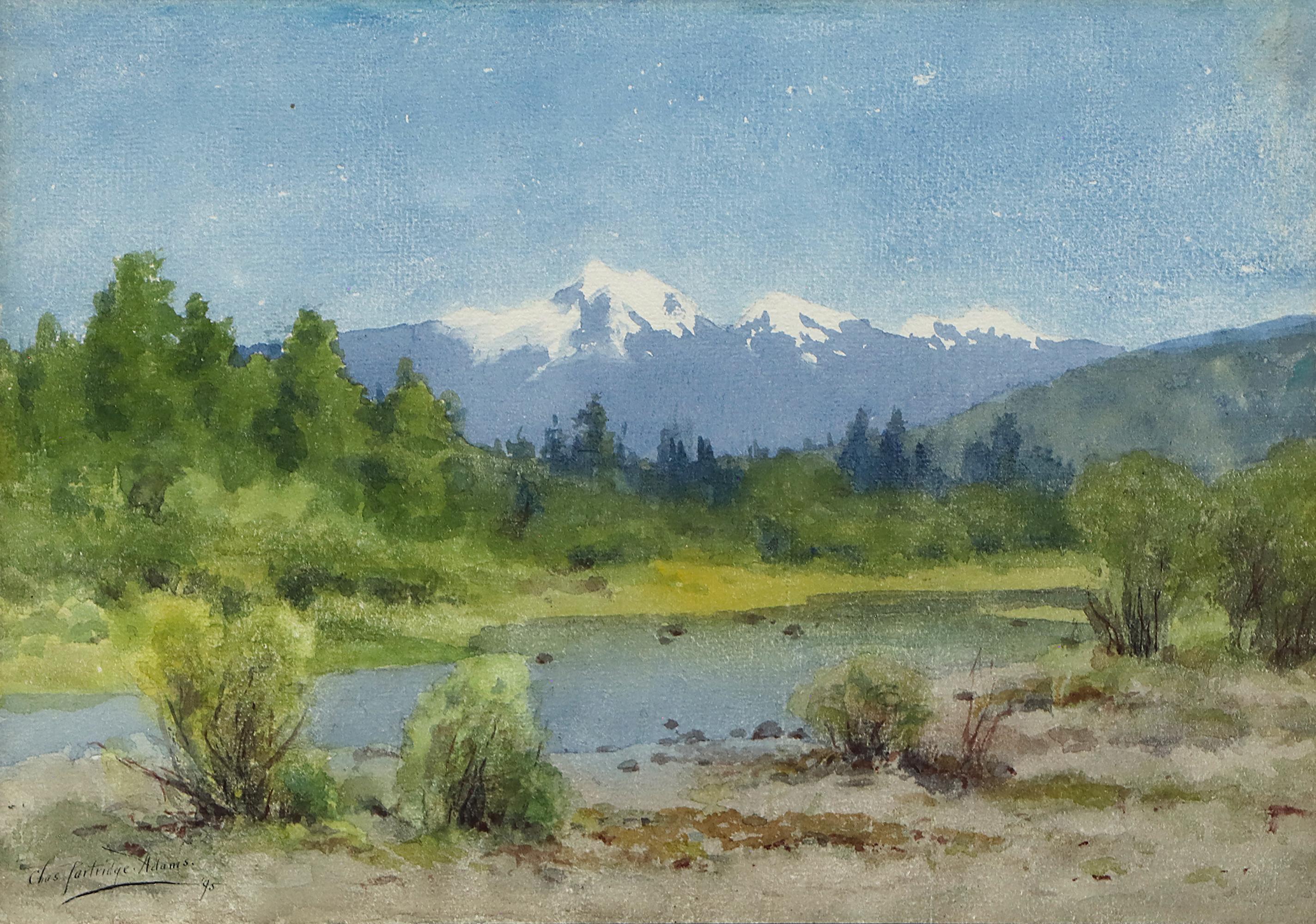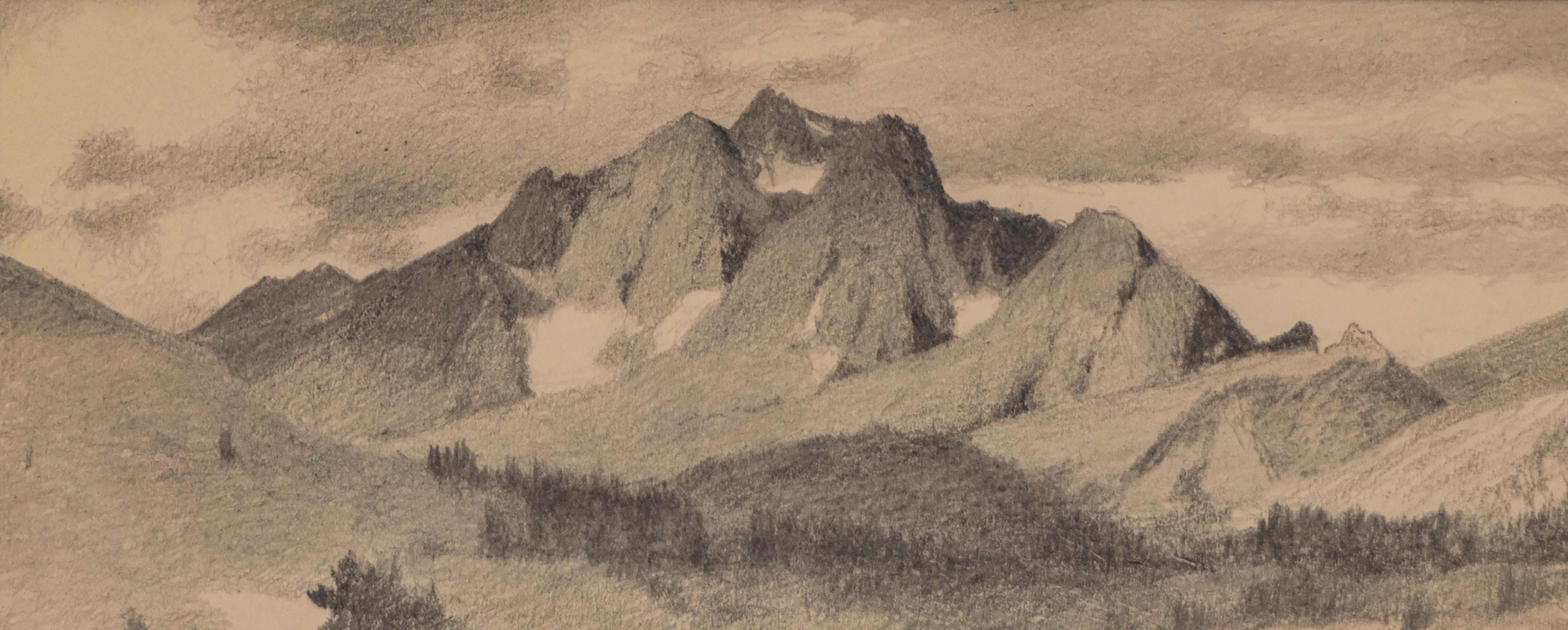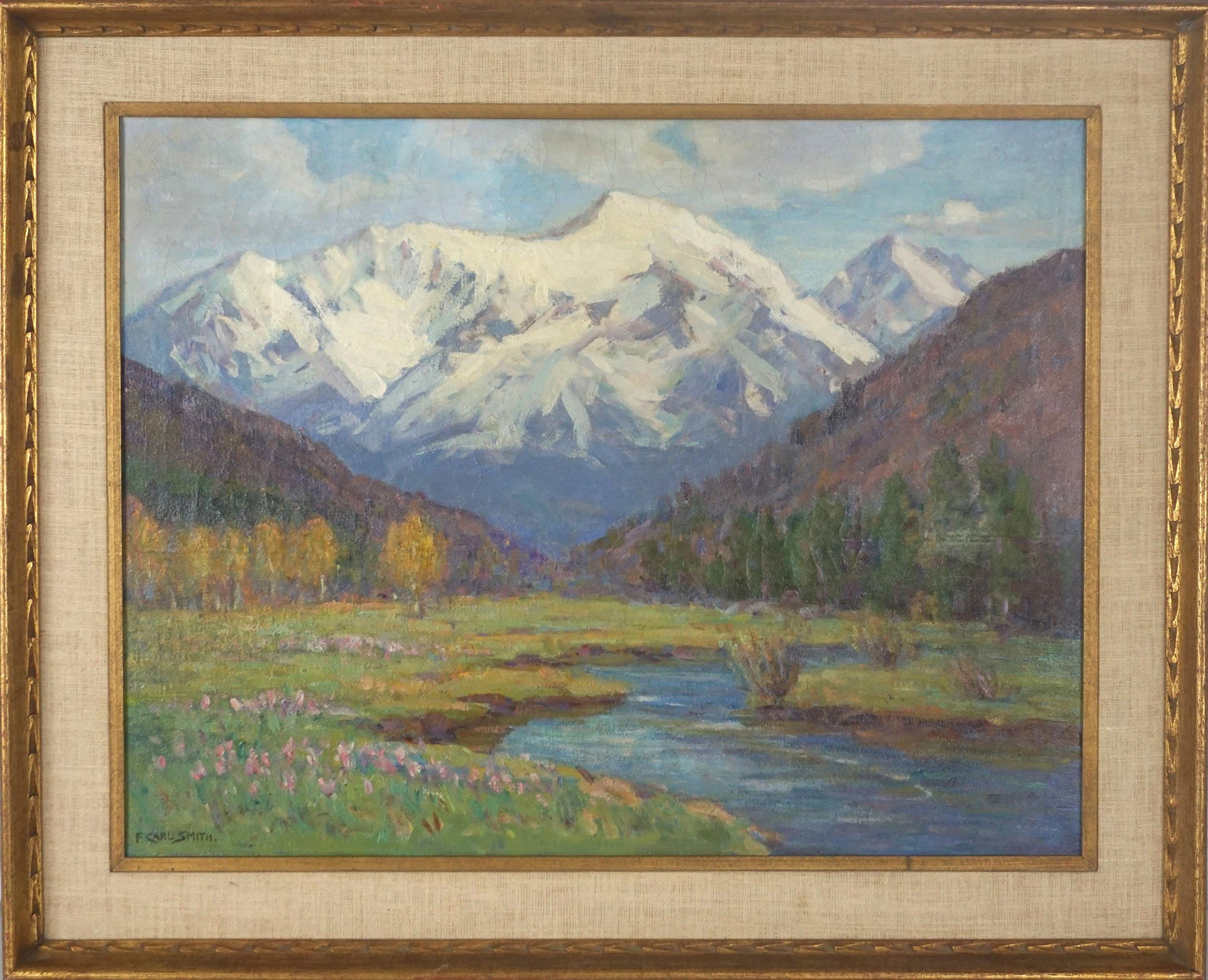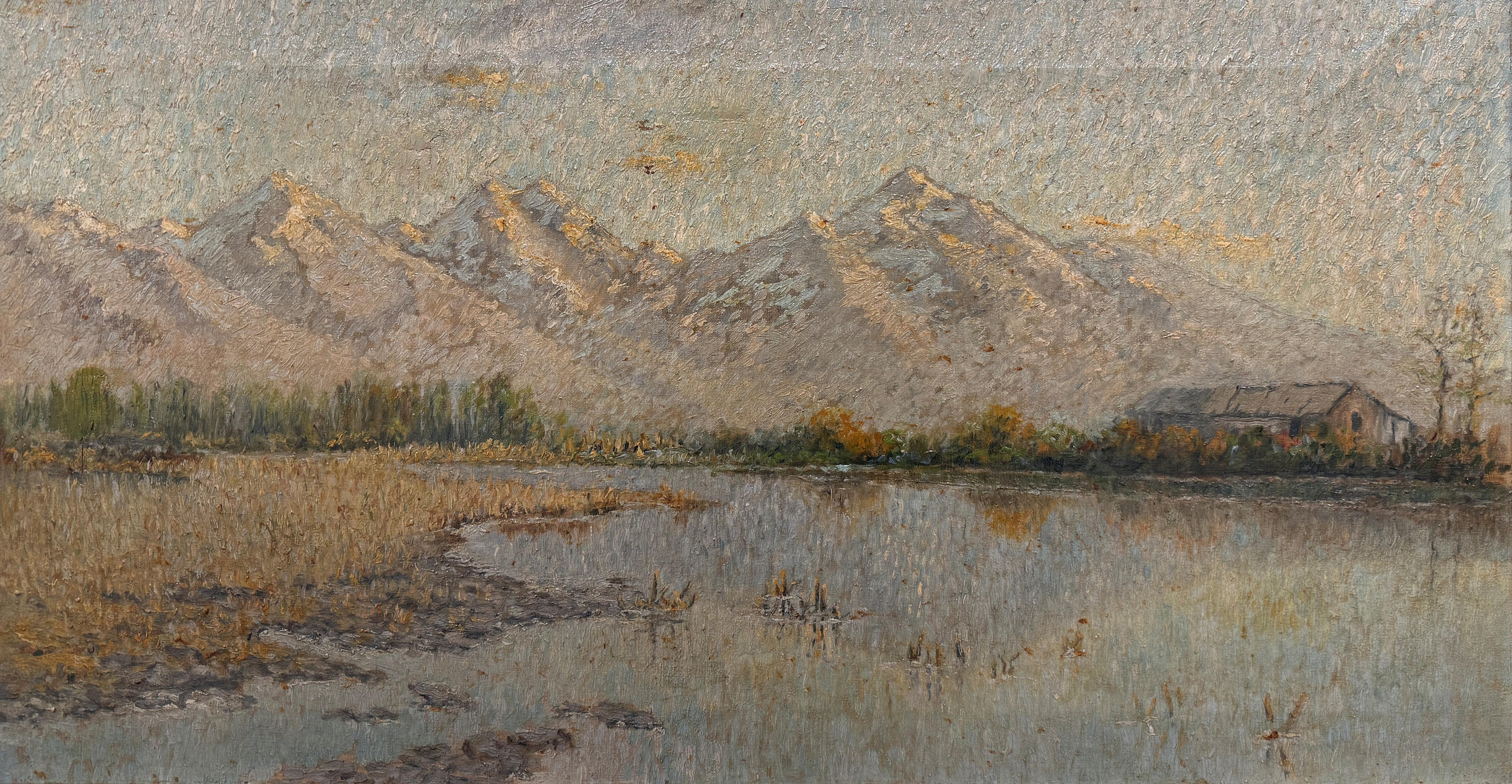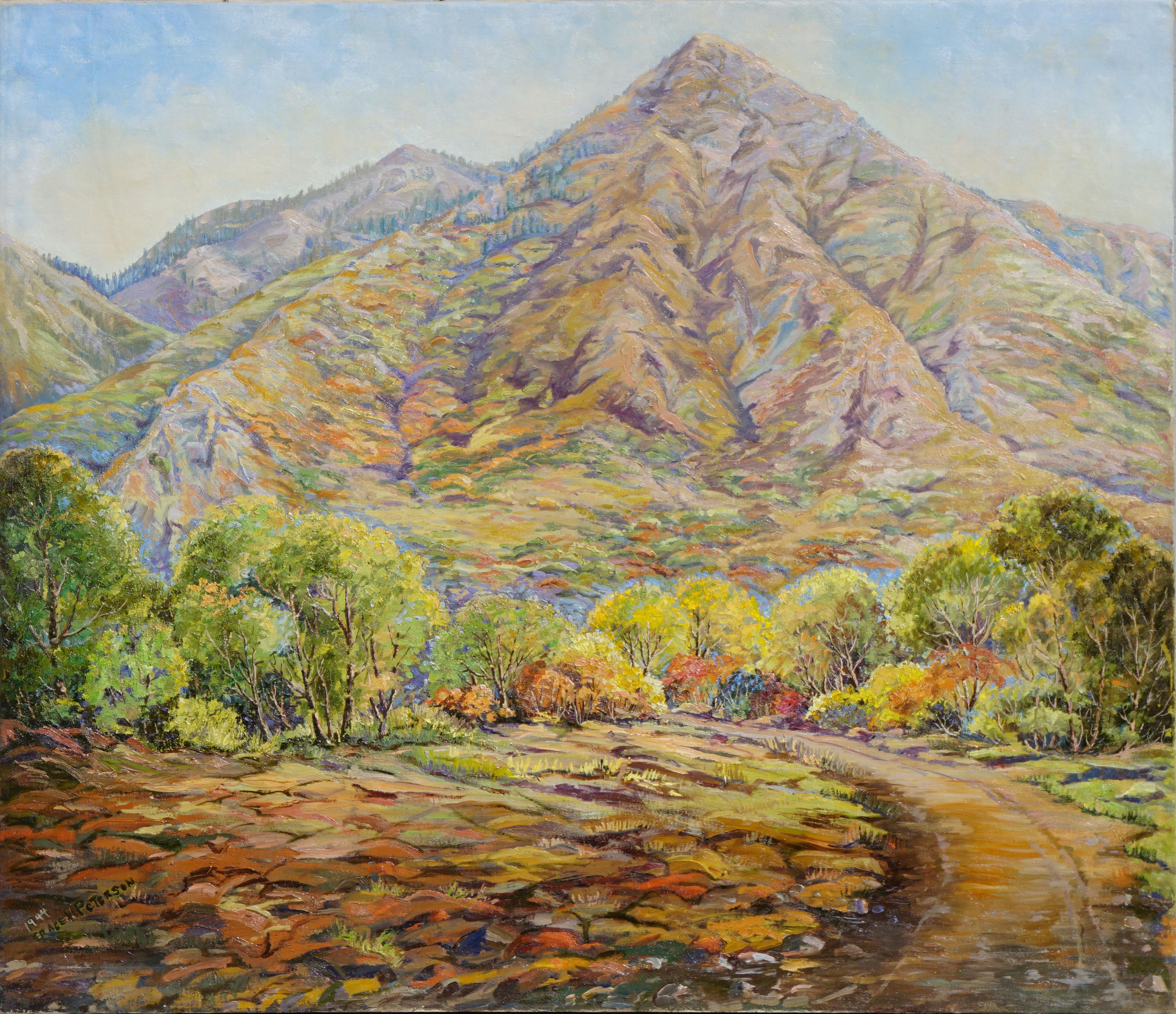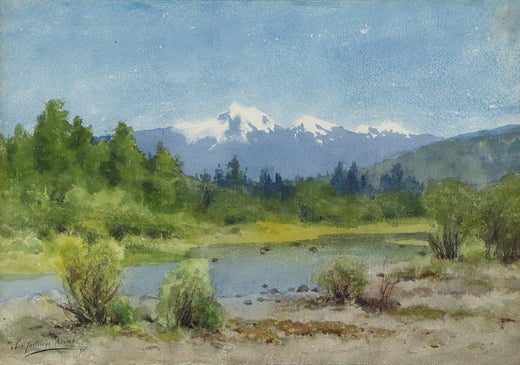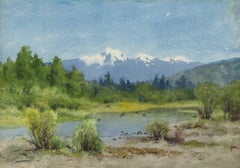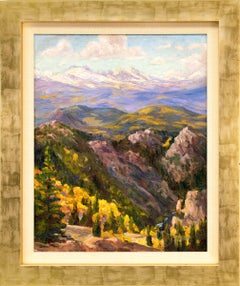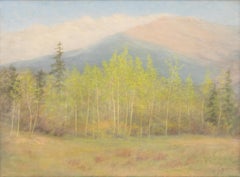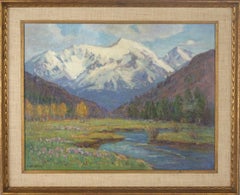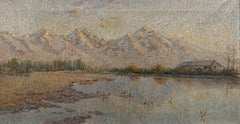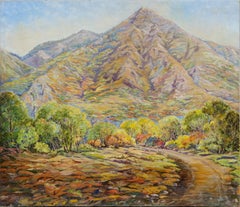Items Similar to Charles Partridge Adams, Colorado Landscape Gouache, 20th-Century Plein Air Art
Video Loading
Want more images or videos?
Request additional images or videos from the seller
1 of 13
Charles Partridge AdamsCharles Partridge Adams, Colorado Landscape Gouache, 20th-Century Plein Air Artcirca 1910
circa 1910
$1,880
£1,432.86
€1,637.85
CA$2,645.04
A$2,897.56
CHF 1,525.16
MX$34,583.15
NOK 19,441.97
SEK 17,772.89
DKK 12,234.48
About the Item
This original circa 1910s plein air field study by celebrated Colorado landscape painter Charles Partridge Adams (1858–1942) beautifully captures the tranquil majesty of the Rocky Mountains. Executed in gouache on paper, the composition embodies the spirit of American Impressionism, showcasing Adams’s keen sensitivity to light, color, and atmosphere.
The scene presents a sweeping view of towering mountain peaks beneath a luminous, shifting sky, with clusters of dark green evergreens grounding the foreground. Wisps of drifting clouds accent the horizon, suggesting the crisp air and atmospheric clarity of a spring day in Colorado’s high country. Adams’s fluid brushwork and subtle layering of tones lend the work both immediacy and depth, reflecting the spontaneity of an artist working directly from nature.
Elegantly presented in a custom vintage frame with an archival mat and UV70 protectant glass, this painting has been carefully preserved for long-term enjoyment.
Frame dimensions: 13.75 x 17.75 inches
Visible image size: 6.5 x 10.75 inches
A rare and intimate field study from Adams’s outdoor practice, this piece is accompanied by provenance from the Estate of Charles Partridge Adams along with a Letter of Authenticity.
Highly collectible, this work offers both historical significance and aesthetic beauty, making it ideal for collectors of Western American art, early 20th-century landscapes, and museum-quality Colorado paintings.
About the Artist:
Charles Partridge Adams (1858–1942) was a pioneering Colorado landscape painter known for his depictions of the Rocky Mountains, foothills, and high plains. Celebrated for his plein air technique and American Impressionist style, Adams captured the dramatic light, rugged terrain, and atmospheric beauty of the Colorado wilderness with remarkable sensitivity. His works were widely exhibited during his lifetime and remain highly sought after by collectors of Western American art, regional landscapes, and early 20th-century Impressionism, celebrated for their technical mastery and evocative sense of place.
- Creator:Charles Partridge Adams (1858-1942, American)
- Creation Year:circa 1910
- Dimensions:Height: 13.75 in (34.93 cm)Width: 17.75 in (45.09 cm)Depth: 0.75 in (1.91 cm)
- Medium:
- Movement & Style:
- Period:
- Framing:Frame IncludedFraming Options Available
- Condition:
- Gallery Location:Denver, CO
- Reference Number:Seller: 253651stDibs: LU27316218322
Charles Partridge Adams
Born in Franklin, Massachusetts, Charles Partridge Adams moved with his mother and two sisters to Denver, Colorado, in 1876 in an effort to cure the two girls who suffered from tuberculosis. In Denver, Adams found work at the Chain and Hardy Bookstore. He received his first, and only, art training from the owner's wife, Helen Chain. Mrs. Chain, a former pupil of George Inness, provided instruction and encouragement to the young artist and introduced him to other artists in the area including Alexander Phimister Proctor. Proctor and Adams developed a friendship and the pair embarked on a three-month camping trip in Egeria Park, Colorado. In addition to exploring, both artists did quite a bit of sketching on the trip. After their return to Denver, Adams and Proctor shared a studio for a short period of time before Proctor moved to New York. Adams remained in Denver and after a short stint as an art teacher he studied wood engraving with Major J.M. Bagley. He quickly abandoned the engraving for health reasons and began working in crayon. His business card read "Landscapes and Crayon Portraits" though he much preferred landscapes. The artist soon made a name for himself in Denver. He established a wealthy clientele that purchased a number of his paintings to decorate their homes and to give as Christmas gifts. In 1890, Adams married Alida Joslin Reynolds and the couple honeymooned in Estes Park, Colorado. That same year, he exhibited for the first time at the National Academy of Design. Three years later, the artist opened his first studio on Larimer Street in Denver. He began working in watercolor and had success in the new medium selling his paintings in stores in Colorado Springs, Pueblo, Kansas City, and Chicago. Also in 1893, Adams became a charter member of the Denver Artists Club. In 1905, the couples dream of living in Estes Park was realized when Adams completed construction on a home and studio there. Adams referred to the studio as "The Sketch Box" and the family spent summers there every year. Though Adams is best known for his Colorado landscapes, he also painted in Yellowstone, the Tetons, the Canadian Rockies, the New Mexican Desert, and California. In 1914, the couple sailed to Europe where they spent five months touring. Three years later, Charles suffered from a near-fatal illness. In 1920, Adams moved to California where he opened a studio first in Pasadena and later in Laguna Beach. He became a member of the Laguna Beach Artists Association and began painting marine subjects. ©David Cook Galleries, LLC
About the Seller
5.0
Vetted Professional Seller
Every seller passes strict standards for authenticity and reliability
Established in 1979
1stDibs seller since 2013
300 sales on 1stDibs
Typical response time: 1 hour
- ShippingRetrieving quote...Shipping from: Denver, CO
- Return Policy
More From This Seller
View AllColorado Mountain Landscape with River, 1890s Watercolor Painting
By Charles Partridge Adams
Located in Denver, CO
This original late 19th-century watercolor painting beautifully captures a classic Colorado mountain landscape by iconic early 20th century artist, Charles Partridge Adams. The compo...
Category
1980s American Impressionist Landscape Paintings
Materials
Watercolor
1910 Colorado Plein Air Landscape Sketch – Mountains, Valley & Field Drawing
By Charles Partridge Adams
Located in Denver, CO
This original circa 1910 graphite landscape drawing is a rare and intimate work by renowned Colorado artist Charles Partridge Adams (1858–1942), celebrated for his mastery of the Ame...
Category
1910s American Impressionist Landscape Drawings and Watercolors
Materials
Graphite
Boulder Canyon, Colorado Autumn Landscape Oil Painting by Irene Fowler, 1940s
By Irene Fowler
Located in Denver, CO
This vintage 1940s oil on canvas painting by Colorado artist Irene Fowler (1884–1969) beautifully captures the vibrant autumn landscape of Boulder Canyon. With a masterful eye for color and atmosphere, Fowler presents majestic mountain peaks framed by glowing Aspen trees in their fall brilliance, their leaves shimmering in radiant shades of gold, orange, and red. The scene reflects both the serenity and dramatic character of Colorado’s rugged wilderness, offering a timeless vision of the Rocky Mountains.
Fowler’s keen observation of light and painterly brushwork bring the landscape vividly to life, evoking the crisp mountain air and golden glow of a Colorado autumn day. Her ability to balance natural grandeur with intimate detail makes this work an exceptional example of early 20th-century Western American painting.
The painting itself measures 22 ¼ x 18 ¼ inches and is presented in a custom gilded frame with outer dimensions of 25 ¼ x 21 ¼ x 1 ½ inches, enhancing its elegance and making it ready for display. Signed by the artist in the lower right corner.
About the Artist:
Irene Fowler (1884–1969) was a pivotal figure in Denver’s early 20th-century art community. Born in Illinois, she later settled in Colorado, where she became both a respected public school teacher and a founding member of the Denver Artists Guild (now the Colorado Artists Guild). Best known for her en plein air landscapes, Fowler captured the beauty of Colorado’s mountains, Aspen groves, and mining towns with an extraordinary sensitivity to light, color, and atmosphere.
She exhibited widely throughout her career, including at the Schlier Gallery, Chappell House, University Club...
Category
1940s American Impressionist Landscape Paintings
Materials
Oil
Albert Stokes Bancroft Aspen Craig Meadows in Spring 1920 Colorado Oil
Located in Denver, CO
“Aspen, Craig Meadows in Spring” is a captivating circa 1920 original oil painting by noted American landscape artist Albert Stokes Bancroft (1862–1946). This beautifully rendered wo...
Category
1920s American Impressionist Landscape Paintings
Materials
Oil
Charles Partridge Adams Original Colorado Landscape Drawing, Vintage Western Art
By Charles Partridge Adams
Located in Denver, CO
Own a rare original vintage field study drawing by celebrated Colorado landscape artist Charles Partridge Adams (1858–1942). This expressive ink-on-paper composition vividly captures...
Category
Early 20th Century American Impressionist Landscape Drawings and Waterco...
Materials
Ink
Robert Alexander Graham Vintage Western Landscape, Golden Colorado Oil Painting
By Robert Alexander Graham
Located in Denver, CO
Experience the breathtaking beauty of Golden, Colorado, through this exquisite vintage oil painting on canvas by acclaimed American artist Robert Alexander Graham (1873–1946). Create...
Category
1920s American Impressionist Landscape Paintings
Materials
Oil
You May Also Like
Antique Impressionist Painting "Spanish Peaks" Colorado Mountain Landscape 1900
By Charles Partridge Adams
Located in Portland, OR
A very attractive American Impressionist watercolor & gouache painting, "The Spanish Peaks" Colorado mountain landscape scene, by Charles Partridge Adams (1858-1942), circa 1900.
Thi...
Category
Early 1900s American Impressionist Landscape Drawings and Watercolors
Materials
Watercolor, Gouache
Early 20th Century Original Oil Painting Landscape -- High Sierras Alpine Meadow
Located in Soquel, CA
Early 20th Century Original Oil Painting Landscape -- High Sierras Spring Alpine Meadow by Frederick Carl Smith
This painting is a classic exampl...
Category
1920s Impressionist Landscape Paintings
Materials
Linen, Oil, Stretcher Bars
"Wasatch Range, Utah" James Taylor Harwood, Western Landscape, Mormon LDS
By James Taylor Harwood
Located in New York, NY
James Taylor Harwood
Wasatch Range, Utah
Inscribed "Wasatch Range, Utah" on the stretcher
Oil on canvas
16 x 31 inches
Provenance
Blanche M. Swan
Private Collection
James Taylor Ha...
Category
1910s American Impressionist Landscape Paintings
Materials
Canvas, Oil
Ogden, Utah in Spring - Mid Century Mountain Landscape
By Grace Peterson
Located in Soquel, CA
Wonderful mid-century impressionistic landscape of Ogden, Utah mountain foothills by Grace H. Peterson (American, 20th Century), 1944. Signed and dated...
Category
1940s American Impressionist Landscape Paintings
Materials
Canvas, Oil
$2,280 Sale Price
20% Off
A Western Mountain Scene
Located in San Francisco, CA
Snow-topped jagged peaks reflected in a mountain lake come together in this ethereal landscape painting by noted American artist Courtney Luther Miles (1887-1975). Self-taught and ac...
Category
Mid-20th Century American Impressionist Landscape Paintings
Materials
Canvas, Oil
American Impressionist Panoramic Mountain Sketch Landscape & Sky Study Painting
By George Browne
Located in Buffalo, NY
Antique American oil painting of panoramic mountain range by George Browne (1918 - 1958). Oil on board, circa 1940. Signed on verso. Displayed in a period giltwood frame. Image, 1...
Category
1940s Impressionist Landscape Paintings
Materials
Canvas, Oil
More Ways To Browse
Antique Springs
Antique Colorado
1940 Street Scenes
1950s Painting Landscape American
Antique Hay Cart
Antique Hay Trolley
Aspen Grove
Boat Yards
Boston Landscape Paintings
Capri Italy Art
Edgar Payne
Fox Hound Painting
Freeman Oil Paintings
French Impressionist 1910
French Ocean Paintings
Grzegorz Wojcik
Jean Dulac
Kevin Macpherson
